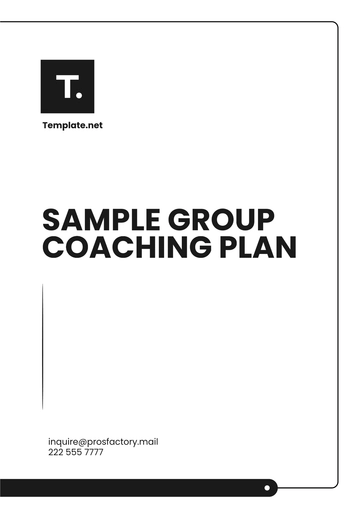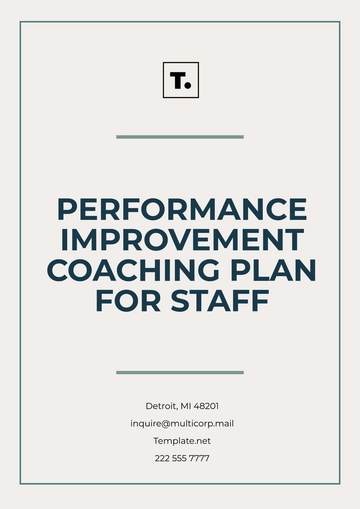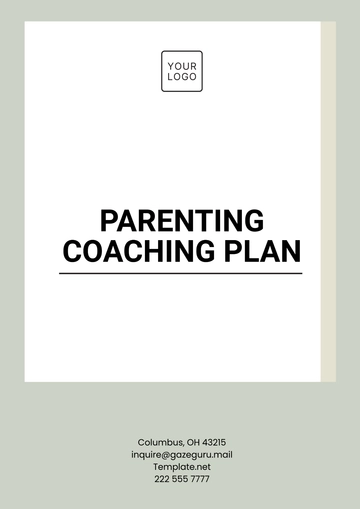Free Stress Management Coaching Plan

Prepared by: [Your Name]
Date: [Date]
I. Introduction
Stress is a natural part of life, but chronic stress can have a detrimental impact on an individual's physical health, emotional well-being, and productivity. This coaching plan is designed to help individuals understand their stress triggers, develop coping strategies, and create long-term habits to manage stress effectively. The goal is to help clients feel more in control of their stress and improve their overall quality of life.
II. Stress Triggers
Identifying and understanding the sources of stress is critical to managing it effectively. Stress triggers can vary greatly from person to person, but they often fall into two broad categories: personal and environmental stressors.
A. Personal Stressors
Personal stressors are those that stem from an individual's inner world, often related to their emotions, thoughts, and experiences.
Workplace Demands: Tight deadlines, high expectations, and an overwhelming workload can cause significant stress. For example, an employee might feel pressured when managing multiple projects at once or facing an unmanageable number of tasks.
Relationship Stress: Family responsibilities, conflicts with friends or colleagues, and difficulties in romantic relationships can also cause emotional strain. For instance, trying to balance work and family life may lead to stress for a caregiver.
Health Issues: Chronic illness or sudden health problems can trigger stress, as individuals worry about their well-being or face limitations due to their health. A person experiencing anxiety about a medical diagnosis may also encounter increased stress.
Perfectionism: Setting unrealistically high expectations for oneself in personal or professional life can lead to feelings of inadequacy and anxiety. The desire to be perfect often leaves little room for mistakes or self-compassion.
B. Environmental Stressors
Environmental stressors are external factors that influence how a person feels. They often stem from the world around them, including work, home, or societal pressures.
Financial Strain: Struggling with finances, whether through mounting debts or unexpected expenses, can create significant stress. The worry about covering bills, securing a steady income, or planning for the future can be overwhelming.
Time Pressures: With the demands of both work and personal life, many individuals struggle to balance time effectively. Lack of time for self-care or leisure can cause feelings of burnout.
Unhealthy Work Environment: Toxic workplaces where employees feel unsupported, undervalued, or constantly micromanaged can elevate stress levels. High levels of conflict or lack of recognition can also contribute to stress.
Life Transitions: Major life changes, such as moving to a new city, changing jobs, or experiencing a breakup, can be a source of stress as individuals cope with new challenges and uncertainties.
III. Coping Strategies
Effective coping strategies help reduce stress by managing both physical and emotional responses. These strategies are meant to provide immediate relief while promoting long-term well-being.
A. Relaxation Techniques
Relaxation techniques are simple methods that help calm the body and mind, reducing the immediate effects of stress.
Deep Breathing Exercises: A technique that focuses on controlled breathing to activate the body’s relaxation response. Practicing deep breathing for five minutes can significantly reduce heart rate and stress levels.
Example: Inhale for a count of four, hold the breath for seven counts, and exhale for eight counts. Repeat for five cycles.
Progressive Muscle Relaxation (PMR): This technique involves tensing and relaxing muscle groups progressively, which helps relieve physical tension associated with stress.
Example: Start from the toes and work upwards, tensing each muscle group for 5-10 seconds before releasing and allowing the muscle to relax completely.
Guided Meditation or Mindfulness: These practices help individuals focus their attention on the present moment, reducing overthinking and mental clutter. Guided meditation can be done through apps like Calm or Headspace.
Example: Practicing mindfulness during a 5-minute break at work by focusing on breathing and being aware of the present moment.
B. Physical Activity
Exercise is a highly effective stress reliever because it releases endorphins, the body's natural mood boosters. Regular physical activity also helps improve sleep, reduce anxiety, and increase overall energy levels.
Aerobic Exercise: Activities like walking, running, or cycling increase heart rate and reduce stress hormones such as cortisol. Just 30 minutes of moderate exercise, 3-5 times a week, can significantly reduce stress.
Yoga and Stretching: Yoga promotes relaxation and helps stretch out tension in the body. Stretching at the start or end of the day can relieve stress caused by tight muscles, especially after long hours of sitting at a desk.
Example: A morning yoga session focused on breathing and gentle stretching can set a calm tone for the day.
C. Time Management
Effective time management can reduce stress by ensuring that tasks are completed on time without last-minute rushes or feeling overwhelmed by responsibilities.
Prioritize Tasks: Use tools like the Eisenhower Matrix to categorize tasks based on urgency and importance. Focus on high-priority tasks first and delegate or defer less critical ones.
Example: Create a to-do list each day and identify the top three tasks to complete before the end of the day.
Set Realistic Goals: Break large tasks into smaller, manageable steps. Use the SMART (Specific, Measurable, Achievable, Relevant, Time-bound) goal-setting technique to ensure that goals are clear and attainable.
Avoid Multitasking: Focusing on one task at a time can reduce mistakes and prevent burnout, leading to better productivity and lower stress levels.
D. Support Systems
A strong support system is crucial for managing stress. Talking to others and seeking advice or guidance can provide emotional relief and practical solutions to stress-related problems.
Talking to a Trusted Friend or Family Member: Sometimes, just having a conversation with someone can alleviate stress. Open communication about feelings and challenges can help provide clarity and support.
Example: Schedule a weekly check-in with a close friend or family member to discuss any stressors and exchange advice.
Professional Help: Therapists, counselors, and stress management coaches can help individuals gain a deeper understanding of their stress and provide tailored strategies for managing it.
Example: If stress becomes overwhelming or persistent, seeking therapy may provide more long-term relief.
IV. Resources
Having the right tools and resources makes it easier to implement and maintain effective stress management practices.
A. Digital Tools
Digital resources can provide guided support and help track progress in managing stress.
Stress Management Apps: Apps such as Calm, Headspace, and Insight Timer offer meditation exercises, breathing techniques, and stress reduction activities.
Time Management Tools: Platforms like Trello, Todoist, and Asana help organize tasks, set deadlines, and prioritize responsibilities effectively.
B. Professional Support
Mental Health Professionals: Consulting with a therapist or counselor can provide personalized coping strategies, emotional support, and long-term stress management techniques.
Wellness Programs: Some companies offer wellness programs that include stress management workshops, access to counseling, and other resources.
V. Action Plan
The action plan provides concrete steps for clients to incorporate stress management practices into their daily lives. The plan should be tailored to each individual’s unique needs and circumstances.
A. Daily Practices
Mindfulness Practice: Begin each day with 5-10 minutes of mindfulness or breathing exercises to set a calm tone for the day.
Movement Breaks: Incorporate short breaks every hour to stretch or walk for a few minutes to avoid burnout and reduce physical stress.
Healthy Eating: Incorporate balanced meals and snacks that stabilize energy levels, avoiding excess caffeine or sugar that can increase stress.
B. Weekly Goals
Reevaluate Stressors: Every week, reflect on new stressors that have emerged and adapt your strategies accordingly.
Relaxation Time: Set aside time each week to do something you love, whether it's reading, going for a walk, or engaging in a hobby that brings you joy.
C. Long-Term Strategies
Regular Check-ins: Evaluate progress every month and adjust your stress management plan if necessary.
Develop Healthy Routines: Build habits like regular exercise, balanced nutrition, and sleep routines to maintain stress resilience over time.
VI. Evaluation
Regularly evaluating the plan helps determine what’s working and what needs adjustment.
A. Tracking Progress
Stress Journal: Keep a daily or weekly log of your stress levels and triggers to better understand patterns.
Example: On a scale of 1-10, rate your stress levels each day and note specific events that triggered higher stress levels.
Stress Reduction Tracking: Track activities you’ve implemented, such as meditation or exercise, and evaluate their effectiveness in reducing stress.
B. Adjustments
Modify Techniques: If certain strategies aren’t effective, try new techniques such as different forms of exercise or mindfulness practices.
Celebrate Progress: Acknowledge small victories in managing stress to stay motivated and reinforce positive habits.
- 100% Customizable, free editor
- Access 1 Million+ Templates, photo’s & graphics
- Download or share as a template
- Click and replace photos, graphics, text, backgrounds
- Resize, crop, AI write & more
- Access advanced editor
Help your clients manage stress effectively with the Stress Management Coaching Plan Template from Template.net. This editable and customizable template is designed to help you create tailored stress-reduction strategies for your clients. Whether it's implementing relaxation techniques or creating actionable goals, the Ai Editor Tool makes it easy to adjust the plan to meet individual needs.
You may also like
- Finance Plan
- Construction Plan
- Sales Plan
- Development Plan
- Career Plan
- Budget Plan
- HR Plan
- Education Plan
- Transition Plan
- Work Plan
- Training Plan
- Communication Plan
- Operation Plan
- Health And Safety Plan
- Strategy Plan
- Professional Development Plan
- Advertising Plan
- Risk Management Plan
- Restaurant Plan
- School Plan
- Nursing Home Patient Care Plan
- Nursing Care Plan
- Plan Event
- Startup Plan
- Social Media Plan
- Staffing Plan
- Annual Plan
- Content Plan
- Payment Plan
- Implementation Plan
- Hotel Plan
- Workout Plan
- Accounting Plan
- Campaign Plan
- Essay Plan
- 30 60 90 Day Plan
- Research Plan
- Recruitment Plan
- 90 Day Plan
- Quarterly Plan
- Emergency Plan
- 5 Year Plan
- Gym Plan
- Personal Plan
- IT and Software Plan
- Treatment Plan
- Real Estate Plan
- Law Firm Plan
- Healthcare Plan
- Improvement Plan
- Media Plan
- 5 Year Business Plan
- Learning Plan
- Marketing Campaign Plan
- Travel Agency Plan
- Cleaning Services Plan
- Interior Design Plan
- Performance Plan
- PR Plan
- Birth Plan
- Life Plan
- SEO Plan
- Disaster Recovery Plan
- Continuity Plan
- Launch Plan
- Legal Plan
- Behavior Plan
- Performance Improvement Plan
- Salon Plan
- Security Plan
- Security Management Plan
- Employee Development Plan
- Quality Plan
- Service Improvement Plan
- Growth Plan
- Incident Response Plan
- Basketball Plan
- Emergency Action Plan
- Product Launch Plan
- Spa Plan
- Employee Training Plan
- Data Analysis Plan
- Employee Action Plan
- Territory Plan
- Audit Plan
- Classroom Plan
- Activity Plan
- Parenting Plan
- Care Plan
- Project Execution Plan
- Exercise Plan
- Internship Plan
- Software Development Plan
- Continuous Improvement Plan
- Leave Plan
- 90 Day Sales Plan
- Advertising Agency Plan
- Employee Transition Plan
- Smart Action Plan
- Workplace Safety Plan
- Behavior Change Plan
- Contingency Plan
- Continuity of Operations Plan
- Health Plan
- Quality Control Plan
- Self Plan
- Sports Development Plan
- Change Management Plan
- Ecommerce Plan
- Personal Financial Plan
- Process Improvement Plan
- 30-60-90 Day Sales Plan
- Crisis Management Plan
- Engagement Plan
- Execution Plan
- Pandemic Plan
- Quality Assurance Plan
- Service Continuity Plan
- Agile Project Plan
- Fundraising Plan
- Job Transition Plan
- Asset Maintenance Plan
- Maintenance Plan
- Software Test Plan
- Staff Training and Development Plan
- 3 Year Plan
- Brand Activation Plan
- Release Plan
- Resource Plan
- Risk Mitigation Plan
- Teacher Plan
- 30 60 90 Day Plan for New Manager
- Food Safety Plan
- Food Truck Plan
- Hiring Plan
- Quality Management Plan
- Wellness Plan
- Behavior Intervention Plan
- Bonus Plan
- Investment Plan
- Maternity Leave Plan
- Pandemic Response Plan
- Succession Planning
- Coaching Plan
- Configuration Management Plan
- Remote Work Plan
- Self Care Plan
- Teaching Plan
- 100-Day Plan
- HACCP Plan
- Student Plan
- Sustainability Plan
- 30 60 90 Day Plan for Interview
- Access Plan
- Site Specific Safety Plan





























